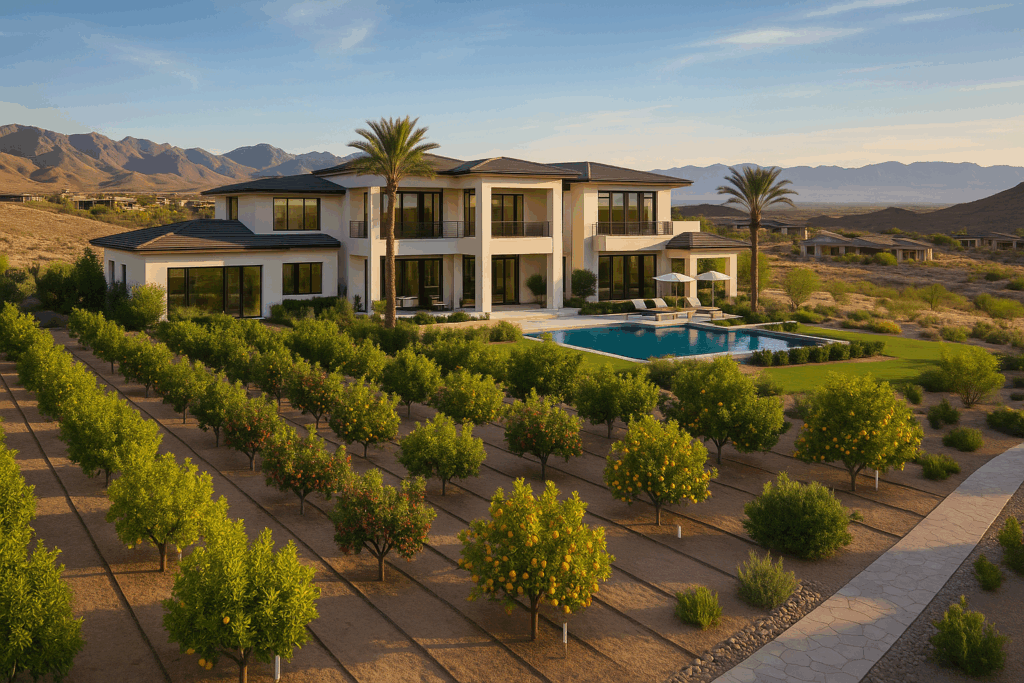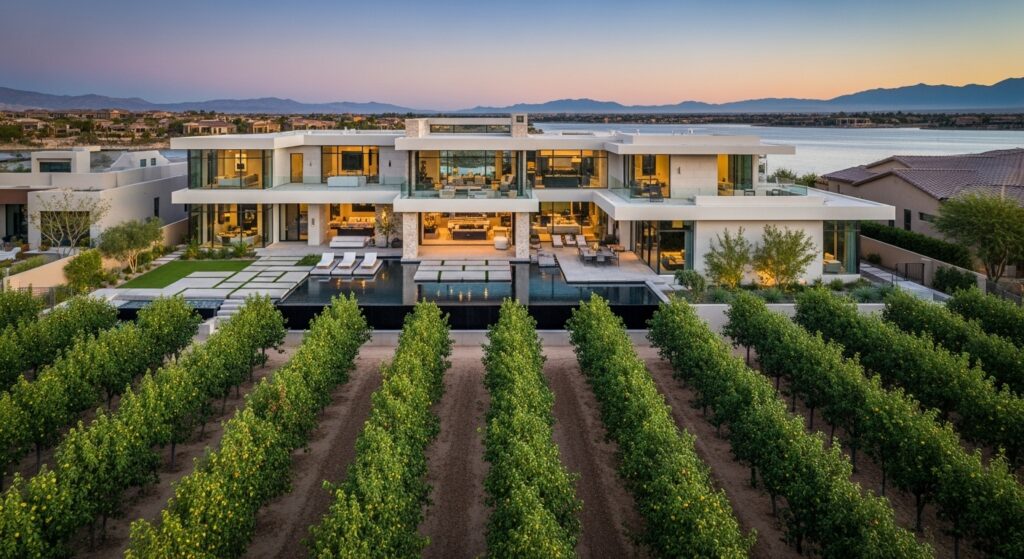
Combining residential elegance with agricultural function is no small feat.
But when executed thoughtfully, an estate integrated with a working fruit orchard becomes not only a place to live, but a long-term asset that produces real value.
Whether you’re aiming to offset carrying costs with orchard income or simply want a self-sustaining retreat, this guide walks you through every major step to bring your vision to life, from raw land to move-in day.
Step 1: Define Your Vision and Scope
Before hiring architects or breaking ground, establish clear answers to three questions:
-
What is the primary goal?
Income-producing orchard, lifestyle estate, or both? -
How much land do you need?
For example, a 4,500 sq ft home with 300 fruit trees typically requires 1.5–2 acres. -
What climate and zoning restrictions apply?
Research local zoning codes (residential-agricultural zoning is ideal) and ensure the area supports year-round or seasonal fruit production.
Step 2: Acquire the Right Parcel of Land
What to Look For
-
Zoning: Residential-ag or estate zoning that allows orchards
-
Utilities: Access to water, sewer/septic, electricity, and internet
-
Topography: Flat or gently sloped land for easy orchard irrigation
-
Soil Type: Ideally well-draining, loamy soil (test before closing)
Timeline: 1–3 months
Key Cost: $300,000 – $500,000 for 2 acres in premium areas is common

Step 3: Hire Your Core Team
You’ll want to assemble the right team early to avoid delays:
-
Owner’s Representative (optional but recommended): Oversees everything on your behalf
-
Custom Home Builder: Preferably design-build to streamline
-
Orchard Consultant / Landscape Designer: For layout, species, and irrigation
-
General Contractor: If not included in design-build
-
Irrigation Specialist: To design the orchard water system
Timeline: 1–2 months to hire and coordinate
Key Cost: $100,000 – $200,000 in planning, design, and professional fees
Step 4: Design the Estate and Orchard Layout
House Design Considerations
-
Position the home for privacy, views, and shade
-
Plan outdoor areas (pool, patio, firepit) to blend with orchard space
-
Account for wind direction and sunlight when orienting windows and trees
Orchard Design Considerations
-
10 ft spacing = ~100 trees per quarter acre
-
Trees grouped by irrigation zone, maturity, and harvest season
-
Include walking paths and work zones (tool shed, compost, etc.)
Timeline: 2–3 months
Key Cost: $60,000 – $100,000 for full architectural plans and orchard layout
Step 5: Obtain Permits and Site Approvals
Every jurisdiction will require permits for:
-
Home construction
-
Septic or utility connection
-
Grading and irrigation
-
Agricultural use (if selling produce)
Your builder or PM will usually handle this, but delays are common if anything is unclear or incomplete.
Timeline: 2–3 months
Key Cost: $10,000 – $25,000

Step 6: Prepare the Land
Site Work Includes:
-
Grading and leveling
-
Soil amendments for the orchard (gypsum, compost)
-
Trenching for utilities and irrigation lines
-
Perimeter fencing and driveways
This phase lays the foundation for everything else—don’t rush it.
Timeline: 1.5 months
Key Cost: $30,000 – $50,000
Step 7: Build the Foundation and Shell
Once the site is ready, the builder begins constructing:
-
Concrete foundation
-
Framing
-
Roofing
-
Windows and doors
This is the point at which the estate begins to visually take shape.
Timeline: 3 months
Key Cost: $300,000 – $400,000
Step 8: Install Irrigation and Prepare Orchard Rows
Orchard Infrastructure Includes:
-
Pressure-regulated drip irrigation system
-
Main and sub-lines for each zone
-
2 emitters per tree for uniform watering
-
Timers and moisture sensors
-
Mulch to retain water and reduce weeds
You should also test your water source (chlorine, pH) before planting.
Timeline: 4 weeks
Key Cost: $10,000 – $15,000

Step 9: Plant Your Trees
Choose drought-tolerant, productive varieties for your climate:
-
Hot/dry climates: Fig, pomegranate, peach, jujube, persimmon
-
Moderate climates: Apple, pear, plum, cherry, citrus
-
Space trees at 10–12 ft intervals and label each by variety and year planted
For a working orchard, plan to plant in phases over 2–3 years so trees mature in cycles and reduce peak labor intensity.
Timeline: 3 weeks
Key Cost: $15,000 – $20,000 for 300 trees and installation
Step 10: Finish Home Interior and Exterior
This phase includes:
-
HVAC, plumbing, electrical
-
Interior finishes: cabinetry, flooring, lighting
-
Smart home systems
-
Outdoor living areas: pool, patios, outdoor kitchen
You can work on soft landscaping (lawns, decorative palms, shrubs) while the interior is completed.
Timeline: 4 months
Key Cost: $500,000 – $650,000
Step 11: Add Hardscape, Lighting, and Furnishings
This includes:
-
Pathways between orchard rows
-
LED lighting along orchard and outdoor entertaining zones
-
Outdoor seating, pergolas, trellises
-
Final furnishing of the home
Timeline: 1–2 months
Key Cost: $75,000 – $150,000

Step 12: Final Inspections and Move-In
Your builder or PM will guide you through:
-
Certificate of Occupancy (CO)
-
Utility startup
-
Smart home programming
-
Final orchard system test
Timeline: 2–3 weeks
Cost: Already included in prior steps
Step-by-Step Timeline Summary
| Phase | Timeline |
|---|---|
| Land acquisition | Month 1–3 |
| Planning & design | Month 3–6 |
| Permits & site work | Month 6–9 |
| Shell construction | Month 9–12 |
| Irrigation + orchard install | Month 12–14 |
| Interior + finishes | Month 13–17 |
| Final touches + move-in | Month 17–18 |
Total Project Cost Estimate
| Component | Cost Range |
|---|---|
| Land | $300,000 – $500,000 |
| House (4,500 sq ft) | $900,000 – $1.2M |
| Orchard & Irrigation | $25,000 – $40,000 |
| Design + Project Mgmt | $100,000 – $200,000 |
| Landscaping + Hardscape | $100,000 – $250,000 |
| Total | $1.45M – $2.2M |
Orchard Income: Offset Carrying Costs
Once mature, a well-run orchard of 300 trees can earn $80,000–$100,000/year through:
-
Farmers markets
-
Chef and restaurant supply
-
CSA boxes or co-op sales
-
Value-added products (jam, dried fruit, juice)
This income can help offset:
-
Property taxes
-
Landscaping labor
-
Utility bills
-
Insurance
-
Maintenance reserves
Final Thoughts
Building an estate with a working fruit orchard is a long but rewarding process.
It takes capital, vision, and patience, but when done right, you get more than a home. You get a generational asset: a place to live beautifully while producing real, recurring value.